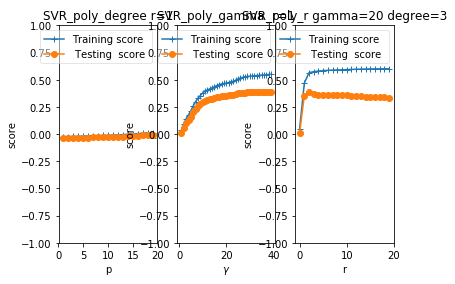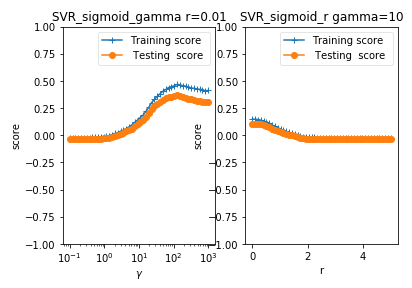import numpy as np import matplotlib.pyplot as plt from sklearn import datasets, linear_model,svm from sklearn.model_selection import train_test_split def load_data_regression(): ''' 加载用于回归问题的数据集 ''' diabetes = datasets.load_diabetes() #使用 scikit-learn 自带的一个糖尿病病人的数据集 # 拆分成训练集和测试集,测试集大小为原始数据集大小的 1/4 return train_test_split(diabetes.data,diabetes.target,test_size=0.25,random_state=0) #支持向量机非线性回归SVR模型 def test_SVR_linear(*data): X_train,X_test,y_train,y_test=data regr=svm.SVR(kernel='linear') regr.fit(X_train,y_train) print('Coefficients:%s, intercept %s'%(regr.coef_,regr.intercept_)) print('Score: %.2f' % regr.score(X_test, y_test)) # 生成用于回归问题的数据集 X_train,X_test,y_train,y_test=load_data_regression() # 调用 test_LinearSVR test_SVR_linear(X_train,X_test,y_train,y_test)

def test_SVR_poly(*data): ''' 测试 多项式核的 SVR 的预测性能随 degree、gamma、coef0 的影响. ''' X_train,X_test,y_train,y_test=data fig=plt.figure() ### 测试 degree #### degrees=range(1,20) train_scores=[] test_scores=[] for degree in degrees: regr=svm.SVR(kernel='poly',degree=degree,coef0=1) regr.fit(X_train,y_train) train_scores.append(regr.score(X_train,y_train)) test_scores.append(regr.score(X_test, y_test)) ax=fig.add_subplot(1,3,1) ax.plot(degrees,train_scores,label="Training score ",marker='+' ) ax.plot(degrees,test_scores,label= " Testing score ",marker='o' ) ax.set_title( "SVR_poly_degree r=1") ax.set_xlabel("p") ax.set_ylabel("score") ax.set_ylim(-1,1.) ax.legend(loc="best",framealpha=0.5) ### 测试 gamma,固定 degree为3, coef0 为 1 #### gammas=range(1,40) train_scores=[] test_scores=[] for gamma in gammas: regr=svm.SVR(kernel='poly',gamma=gamma,degree=3,coef0=1) regr.fit(X_train,y_train) train_scores.append(regr.score(X_train,y_train)) test_scores.append(regr.score(X_test, y_test)) ax=fig.add_subplot(1,3,2) ax.plot(gammas,train_scores,label="Training score ",marker='+' ) ax.plot(gammas,test_scores,label= " Testing score ",marker='o' ) ax.set_title( "SVR_poly_gamma r=1") ax.set_xlabel(r"$\gamma$") ax.set_ylabel("score") ax.set_ylim(-1,1) ax.legend(loc="best",framealpha=0.5) ### 测试 r,固定 gamma 为 20,degree为 3 ###### rs=range(0,20) train_scores=[] test_scores=[] for r in rs: regr=svm.SVR(kernel='poly',gamma=20,degree=3,coef0=r) regr.fit(X_train,y_train) train_scores.append(regr.score(X_train,y_train)) test_scores.append(regr.score(X_test, y_test)) ax=fig.add_subplot(1,3,3) ax.plot(rs,train_scores,label="Training score ",marker='+' ) ax.plot(rs,test_scores,label= " Testing score ",marker='o' ) ax.set_title( "SVR_poly_r gamma=20 degree=3") ax.set_xlabel(r"r") ax.set_ylabel("score") ax.set_ylim(-1,1.) ax.legend(loc="best",framealpha=0.5) plt.show() # 调用 test_SVR_poly test_SVR_poly(X_train,X_test,y_train,y_test)

def test_SVR_rbf(*data): ''' 测试 高斯核的 SVR 的预测性能随 gamma 参数的影响 ''' X_train,X_test,y_train,y_test=data gammas=range(1,20) train_scores=[] test_scores=[] for gamma in gammas: regr=svm.SVR(kernel='rbf',gamma=gamma) regr.fit(X_train,y_train) train_scores.append(regr.score(X_train,y_train)) test_scores.append(regr.score(X_test, y_test)) fig=plt.figure() ax=fig.add_subplot(1,1,1) ax.plot(gammas,train_scores,label="Training score ",marker='+' ) ax.plot(gammas,test_scores,label= " Testing score ",marker='o' ) ax.set_title( "SVR_rbf") ax.set_xlabel(r"$\gamma$") ax.set_ylabel("score") ax.set_ylim(-1,1) ax.legend(loc="best",framealpha=0.5) plt.show() # 调用 test_SVR_rbf test_SVR_rbf(X_train,X_test,y_train,y_test)

def test_SVR_sigmoid(*data): ''' 测试 sigmoid 核的 SVR 的预测性能随 gamma、coef0 的影响. ''' X_train,X_test,y_train,y_test=data fig=plt.figure() ### 测试 gammam,固定 coef0 为 0.01 #### gammas=np.logspace(-1,3) train_scores=[] test_scores=[] for gamma in gammas: regr=svm.SVR(kernel='sigmoid',gamma=gamma,coef0=0.01) regr.fit(X_train,y_train) train_scores.append(regr.score(X_train,y_train)) test_scores.append(regr.score(X_test, y_test)) ax=fig.add_subplot(1,2,1) ax.plot(gammas,train_scores,label="Training score ",marker='+' ) ax.plot(gammas,test_scores,label= " Testing score ",marker='o' ) ax.set_title( "SVR_sigmoid_gamma r=0.01") ax.set_xscale("log") ax.set_xlabel(r"$\gamma$") ax.set_ylabel("score") ax.set_ylim(-1,1) ax.legend(loc="best",framealpha=0.5) ### 测试 r ,固定 gamma 为 10 ###### rs=np.linspace(0,5) train_scores=[] test_scores=[] for r in rs: regr=svm.SVR(kernel='sigmoid',coef0=r,gamma=10) regr.fit(X_train,y_train) train_scores.append(regr.score(X_train,y_train)) test_scores.append(regr.score(X_test, y_test)) ax=fig.add_subplot(1,2,2) ax.plot(rs,train_scores,label="Training score ",marker='+' ) ax.plot(rs,test_scores,label= " Testing score ",marker='o' ) ax.set_title( "SVR_sigmoid_r gamma=10") ax.set_xlabel(r"r") ax.set_ylabel("score") ax.set_ylim(-1,1) ax.legend(loc="best",framealpha=0.5) plt.show() # 调用 test_SVR_sigmoid test_SVR_sigmoid(X_train,X_test,y_train,y_test)
